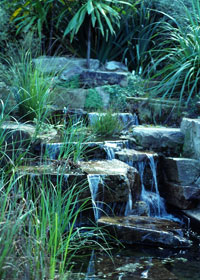Water – smart horticulture at the ANBG
Water targets | Irrigation system | Resources | Non-potable water system
The Gardens uses around 150 megalitres of water per year with most water being used to irrigate the plant collection.
The Australian National Botanic Gardens strives to demonstrate sustainable water use practices and showcase low water use in horticulture. In recent years, the Gardens has implemented a number of water efficiency measures to make significant water savings, including the installation of a new computerised automatic irrigation system and a water infrastructure upgrade to allow use of non-potable water for irrigation.
Water targets
To ensure a long-term sustainable supply of water the Australian National Botanic Gardens has implemented a $2.9 M water infrastructure upgrade enabling use of non-potable water supplied from nearby Lake Burley Griffin to irrigate our living collection. The infrastructure upgrade ensures that valuable drinking water is not used for irrigation, and remains available for the local community. Floresco in the Gardens café is metered separately.
The Gardens demonstrates best-practice horticultural water use through appropriate watering times and amounts and reduced watering of lawns.
Irrigation system
The installation in 2005 – 2006 of an $180,000 computerised irrigation system, Irrinet, formed part of the overall water strategy for the Gardens. The new system has helped the ANBG become more efficient in its irrigation water use. Each horticulturist programs their own water delivery schedule for their sections and receives monthly water usage reports. Knowledge of the plants' water requirements allows them to match the irrigation to the plants' needs.
The analysis of monthly water usage reports highlights any potential problems. Furthermore, the observations of staff and visitors also alert the irrigation officer to any faults in the system. The original steel water pipes used throughout the Gardens are being gradually replaced with PVC plastic pipes. The pipeline bringing non-potable water from Lake Burley Griffin, and the new potable water reticulation system will be laid using HDPE piping, due to its longevity and recyclability.
The automatic irrigation system features a series of drippers, overhead sprinklers, micro-sprayers and ground-level low volume emitters.
The irrigation system consists of:
- a dedicated computer running Irrinet software
- 14 solar-powered, radio controlled water meters on each major line
- 4 solar-powered, radio controlled water valves
- a solar-powered weather station which measures rainfall, temperature, humidity, solar radiation and evaporation.
The Irrinet system is operated from a dedicated PC or by logging in remotely to trouble-shoot or check daily activity. This allows the system to be monitored after hours and the valves can be shut down remotely if required.
Four solar-powered soil moisture sensors are located in different soil types around the Gardens. These sensors are not integrated into the irrigation system, but provide additional information for assessing the soil wetness profile. For instance, the use of the soil sensor in the café lawns can indicate when the lawn is sufficiently well-watered to allow the irrigation system to be turned off.
Resources
- Water Conservation Strategies at the Australian National Botanic Gardens
- Bibliography for Water-Wise Gardening resources
- Some Drought tolerant native plants at the Australian National Botanic Gardens
- Watering - how water is used in various parts of the Gardens
- Non-potable Water System
![Director of National Parks [logo]](../../../images/dnp_90px.gif)






